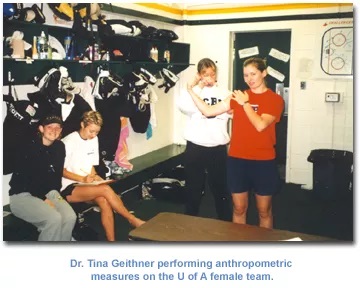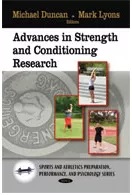
This study analyzed the kinematics of the forward skating stride of Canadian female university hockey players (University of Alberta). We videotaped the players while they performed a 44.80-m (147 feet) skating speed test. We used photoelectric timers to measure skating time.
The analysis was completed by counting the number of strides each subject took during the test. Then we did the following calculations: time, stride rate (strides/sec), velocity (metres/sec), and stride length/width (metres/stride). We analyzed the data with a statistical method called “Linear regression.” This method identifies what the are the best characteristics to predict the speed over 44.80-m. Stride length/width was the best predictor of skating speed (correlation -0.903) than stride rate (correlation = -852). But both stride length/width and stride rate were good predictors of 44.80-m skating speed. Stride length/width was a better predictor of skating velocity (metres/sec) (correlation = 0.907) than stride rate (correlation = 0.860). The results of this study are similar to other studies that found hockey skating speed is based on the width of a players stride and how many times he/she can get the push-off skate on the ice (fast, medium length strides). Based on the results of this study, coaches and skating instructors may be able to improve skating speed by designing and conducting drills that focus on increasing stride length/width. However, there can also be an emphasis on increasing stride rate as it also appears to be important for skating speed.
Bracko, M.R., and Geithner, C.A. A Kinematic Analysis of Skating Speed in Canadian Female University Hockey Players, Applied Physiology, Nutrition, and Metabolism. 34(Supplement), S8, 2009.

This is a chapter in a book entitled Advances in Strength and Conditioning Research published by Nova Publishers, 2009. The title of the chapter I contributed is "Enhancing Performance in Ice-Hockey", Chapter 12. I reviewed as many research studies on hockey as I could find. I reviewed research on 1) hockey physiology, 2) studies on training for hockey, and 3) skating research.
This is an overview of the chapter. For strength and conditioning coaches and hockey coaches, designing training programs can be hard because of there are so many physical demands on hockey players. There is limited research and objective information on the best training programs for hockey and skating skills. It is believed that all the components of fitness are important: muscle strength, power, and endurance, and cardiovascular endurance and anaerobic capacity. The research on training for hockey and skating suggests that upper and lower body muscle strength, power, and endurance are important for skating acceleration and upper body power is important for stick velocity when shooting. We don’t know what off-ice training can improve skating agility which is how players skate during a game.
Research on skating can be confusing if a we look at resent research done with players on skating treadmills. There are biomechanical differences when skating on a treadmill compared to skating on ice. The most obvious difference is that treadmills make a player skate uphill, despite the fact that every hockey rink in the world is flat. Some of the findings in studies done on treadmills contradict how players skate on ice. However, there is good research from studies done on a normal hockey rink that show a coach what characteristics are important for fast, high-performance skating. The aspects of skating that are consistently found to be characteristics of fast skaters include: stride width (wide stride when pushing off), quick and low recovery of the skate after pushing off (slower skaters have a long recovery), quick set of the blade on the ice and turning it into the push-off skate, arm movement side-to-side in equal coordinated movement with the legs, deep knee bend, a lot of forward lean of the trunk, and the ability to move the center of gravity over the base of support to maintain balance.
The results of this study have 3 practical applications: 1) through on and off-ice testing a coach can use the information about players’ physical and performance characteristics to place them in specific positions with greater likelihood of high-performance and team success. Specifically, female hockey players who are leanest and have the best skating agility and anaerobic and aerobic power might be placed as forwards or defensemen and players who are less fit are better suited for being a goalie. 2) with better understanding of the demands of a position in hockey, a coach and players can train to develop the specific abilities needed to be successful at a specific position. And 3), usually coaches use subjective criteria to choosing forward lines and defense pairings, whereas with knowledge of physical and performance characteristics a coach can use a combination of subjective and objective information to put the players together who will work best as it relates to fitness, body type, and skating ability.
Geithner, C.A., Lee, A.M. and Bracko, M.R. Physical and Performance Differences Among Forwards, Defensemen, and Goalies in Elite Women’s Ice Hockey. Journal of Strength and Conditioning Research, 20(3):500 – 505, 2006.
he major differences between 10-16 year old male and female hockey players are: 1) Off-Ice Fitness: males less body fat, higher vertical jump, more playing experience, 2) Skating Performance: males have more speed, 3) On-Ice Fitness: males consistently have higher on-ice anaerobic power. It was concluded that females could not compete against males because males are superior skaters.
Bracko, M.R. Comparison of physical performance characteristics of age-matched female and male ice hockey players. Pediatric Exercise Science, Vol 13, #1, pages 26-34, 2001.
Elite female ice hockey players are older, faster skaters (speed), have a better drop_off %, drop-off time, a lower sum of 6 Repeats in a repeat skate test, and have greater on-ice anaerobic capacity than non-elite players.
Bracko, M.R. On-ice performance characteristics of elite and non-elite female ice hockey players. Journal of Strength and Conditioning Research, Vol 15, #1, pages 42 – 47, 2001.
The results of this study show that 40 yard dash time is the strongest predictor of skating speed in female hockey players age 8 – 16 years old. In other words, the faster a hockey player can run (the more power she has) the faster skater she will be, depending on her ability to skate.
Journal of Strength and Conditioning Research, Vol 15, #1, pages 116-122, 2001.
Compared to hockey players on other National Teams and/or age matched hockey players, the U.S. National Deaf Team had off-ice fitness ranging from 0% to 50% better and on-ice fitness ranging from 32% lower to 1.13% higher.
Diakoumis, K. and Bracko, M.R. On-Ice and Off-Ice Performance Characteristics of the 1998/99 U.S. National Deaf Ice Hockey Team. Medicine & Science in Sports & Exercise (Abstract), 31:S211, 1999.
As a group, these female hockey players were not at risk for disordered eating tendencies. This suggests that they have healthy eating attitudes and behaviors and healthy attitudes toward their bodies. Their body mass index rates in the healthy zone for Canadian population norms. They are considered mesomorphic-endomorphs.
Puddu, C., Geithner, T. and Bracko, M.R. Prevalence of disordered eating tendencies in young female ice hockey players. Medicine & Science in Sports & Exercise (Abstract), 31:S215, 1999.
NHL forwards spend most of their time on the ice gliding on two feet interspersed with cruise strides, medium intensity skating and struggling for the puck or position. They spent equal amounts of time skating at a high intensity and skating backward. They turned left more than right. High point scorers glided on two feet with the puck more than low point scorers, conversely low point scorers had more occurrences of backward º forward skating
Bracko, M.R., Hall, L.T., Fisher, A.G., Fellingham, G.W. and W. Cryer. Performance skating characteristics of professional ice hockey forwards. Sports Medicine, Training and Rehabilitation., 8: 251-263, 1998.
0 yard dash, vertical jump with arm swing, and vertical jump without arm swing are reasonable predictors of skating acceleration and speed for deaf hockey players age 11 – 19 years old. These results concur with prediction data collected on hearing youth, college and professional ice hockey players.
Diakoumis, K. and M.R. Bracko. Prediction of skating performance with off_ice testing in deaf hockey players. Medicine & Science in Sports & Exercise (Abstract), 30:S272, 1998.
Deaf hockey players appear to possess similar performance characteristics as hearing hockey players.
Janaczak, J., Diakoumis, K. and M.R. Bracko. Physical performance characteristics of deaf ice hockey players. Medicine & Science in Sports & Exercise (Abstract). 30:S272, 1998.
Effect on Skating: Jump training had no greater effect on skating performance than did upper body training. The only variable that improved was acceleration, but both groups got better. The jump training group increased their vertical jump and the upper body group improved their push-ups/minute. Lower body, or upper body training, may enhance on-ice acceleration. The on-ice training the players were doing probably did not contribute to the increase in acceleration, otherwise the other skating tests would have improved as well.
Bracko, M.R. and G.W. Fellingham. Effect of jump training on skating performance of ice hockey players. Journal of Strength & Conditioning Research (Abstract), 11(4):278, 1997.
Vertical jump height, push-ups and average mechanical vertical jump power are reasonable predictors of skating acceleration, speed and full speed in youth hockey players age 10 – 14 years old. Consideration of these off-ice variables may be important in the training of youth hockey players.
Bracko, M.R. and G.W. Fellingham. Prediction of ice skating performance with off-ice testing In youth hockey players. Medicine & Science in Sports & Exercise (Abstract). 29:S172, 1997.
There was no shoulder movement that produced a faster 20′ start time. However, most of the players could only produce a side-to-side movement (transverse abduction/adduction).
Bracko, M.R., Fellingham, G.W. & R.D.Lyons. Glenohumeral kinematics: a comparison of three techniques during an ice hockey acceleration test. Medicine & Science in Sports & Exercise (Abstract), 28:S55, 1996.

Istvan Takacs, Romanian National Team, when asked what hockey taught him: "So much about life, about other people, and getting along with them. Through hockey, you learn to respect life and to value people. You learn to listen to your coach, and to your heart. You learn how to let your mind speak with your body, because the two become close after playing all these years."

Hockey Institute – All Rights Reserved – Calgary Web Design by Blue Ocean